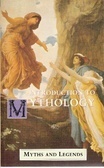What do you think?
Rate this book


336 pages, Paperback
First published May 1, 1921
It will now be clear that in the present volume our concern is with the science of myth alone -- tht is with religious beliefs and conjectures as to the nature of things of primitive, ancient or barbarous peoples and not with modern religious science, philosophy or theology.
I once made a similar criticism of another book, Bantu Prophets in South Africa by Bengt Sundkler. That book was about African Independent Churches, and my article was Sundkler deconstructed: Bethesda AICs and syncretism. In that case, however, Sundkler gave a lot of very useful factual information. It was his opinions, interspersed between the facts he gave, that needed to be deconstructed. So I decided to read Spence's Introduction to Mythology in the hope that the usefulness of the facts would outweigh the arrogance of the opinions. And so, to some extent, it was.
.One of the more useful pieces of information I found in Spence's book (p 24f) was on fetishes and fetishism:
... a fetish is an object which the savage all over the world, in Africa, Asia, America, Australia, and, anciently, in Europe, believes to be inhabited by a spirit or supernatural being. Trees, water, stones are in the "animism" phase considered as the homes of such spirits, which, the savage thinks, are often forced to quit their dwelling places because they are under the spell or potent enchantment of a more powerful being. The fetish may be a bone, a stone, a bundle of feathers, a fossil, a necklace of shells, or any object of peculiar shape or appearance. Into this object the medicine man may lure the wandering or banished spirit, which henceforth becomes his servant; or, again, the spirit of its own will may take up residence there. It is not clear whether, once in residence or imprisonment, the spirit can quit the fetish, but specific instances would point to the belief that it could do so if permitted by its "master."
We must discriminate sharply between a fetish-spirit and a god, although the fetish may develop into a godling or a god. The basic difference between the fetish and the god is that whereas the god is the patron and is invoked by prayer, the fetish is a spirit subservient to the individual owner or tribe and if it would gain the state of godhead it must do so by long or marvellous service as a luck-bringer. Offerings may be made to a fetish, it may even be invoked by a prayer or spell,; but on the other hand it may be severely castigated if it fail to respond to the master's desires.
Spence also gives useful descriptions and summaries of various myths and mythologies from various cultures around the world, and also of the ways in which mythologists in preceding generations, up to his time, had evaluated them. But I found his own evaluations more repellant than many of the others.
In the end, I fall back on the Orthodox philosopher, Nicolas Berdyaev, and prefer what he said about myth in his book Freedom and the Spirit:
Myth is a reality immeasurably greater than concept. It is high time that we stopped identifying myth with invention, with the illusions of primitive mentality, and with anything, in fact, which is essentially opposed to reality... The creation of myths among peoples denotes a real spiritual life, more real indeed than that of abstract concepts and rational thought. Myth is always concrete and expresses life better than abstract thought can do; its nature is bound up with that of symbol. Myth is the concrete recital of events and original
phenomena of the spiritual life symbolized in the natural world, which has engraved itself on the language memory and creative energy of the people... it brings two worlds together symbolically.